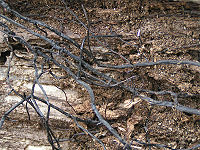
Mycelial cord
Encyclopedia


Hypha
A hypha is a long, branching filamentous structure of a fungus, and also of unrelated Actinobacteria. In most fungi, hyphae are the main mode of vegetative growth, and are collectively called a mycelium; yeasts are unicellular fungi that do not grow as hyphae.-Structure:A hypha consists of one or...
. The mature cords are composed of wide, empty vessel hyphae surrounded by narrower sheathing hyphae. Cords may look similar to plant
Plant
Plants are living organisms belonging to the kingdom Plantae. Precise definitions of the kingdom vary, but as the term is used here, plants include familiar organisms such as trees, flowers, herbs, bushes, grasses, vines, ferns, mosses, and green algae. The group is also called green plants or...
root
Root
In vascular plants, the root is the organ of a plant that typically lies below the surface of the soil. This is not always the case, however, since a root can also be aerial or aerating . Furthermore, a stem normally occurring below ground is not exceptional either...
s, and also frequently have similar functions; hence they are also called rhizomorphs (literally, "root-forms").
Mycelial cords are capable of conducting nutrients over long distances. For instance, they can transfer nutrients to a developing fruiting body, or enable wood-rotting fungi to grow through soil from an established food base in search of new food sources. For parasitic fungi, they can help spread infection by growing from established clusters to uninfected parts. The cords of some wood-rotting fungi (like Serpula lacrymans
Serpula lacrymans
Serpula lacrymans is one of the fungi that are responsible for dry rot. It is a basidiomycete in the order Boletales.-Taxonomy:The species was first described under the name Boletus lacrymans by Franz Xavier von Wulfen in 1781...
) may be capable of penetrating masonry
Masonry
Masonry is the building of structures from individual units laid in and bound together by mortar; the term masonry can also refer to the units themselves. The common materials of masonry construction are brick, stone, marble, granite, travertine, limestone; concrete block, glass block, stucco, and...
.
The mechanism of the cord formation is not yet precisely understood. Mathematical models
Neighbour-sensing model
The neighbour-sensing model is the proposed hypothesis of the fungal morphogenesis. The hypothesis suggests that each hypha in the fungal mycelium generates a certain abstract field that decreases when increasing the distance. The proposed mathematical models deal with both scalar and vector fields...
suggest that some fields or gradient
Gradient
In vector calculus, the gradient of a scalar field is a vector field that points in the direction of the greatest rate of increase of the scalar field, and whose magnitude is the greatest rate of change....
s of signalling chemicals, parallel to the cord axis, may be involved.
Rhizomorphs can grow up to 9 metres in length and 5 mm in diameter.

